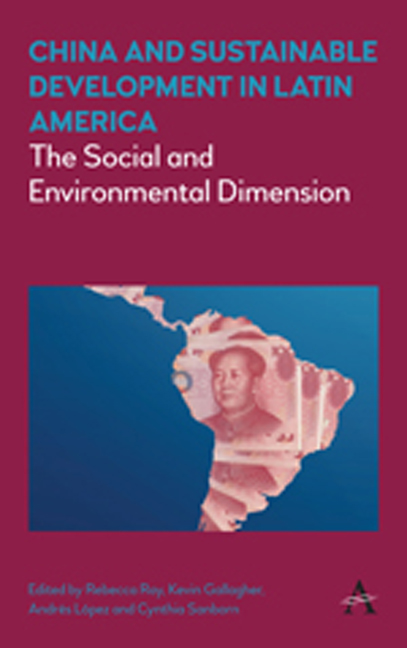Book contents
- Frontmatter
- Contents
- List of Illustrations
- Acknowledgments
- Part I INTRODUCTION AND REGIONAL OVERVIEW
- Part II CHINA'S AND LATIN AMERICA'S HYDROCARBONS SECTORS
- Chapter 2 FDI and Trade: Is China Relevant for the Future of Our Environment? The Case of Argentina
- Chapter 3 Colombia and China: Social and Environmental Impacts of Trade and Foreign Direct Investment
- Chapter 4 A Line in the Equatorial Forests: Chinese Investment and the Environmental and Social Impacts of Extractive Industries in Ecuador
- Part III CHINA'S AND LATIN AMERICA'S MINING SECTORS
- Part IV CHINA'S AND LATIN AMERICA'S AGRICULTURAL SECTORS
- Part V CHINA'S AND LATIN AMERICA'S MANUFACTURING SECTORS
- Notes on Contributors
- Index
Chapter 3 - Colombia and China: Social and Environmental Impacts of Trade and Foreign Direct Investment
from Part II - CHINA'S AND LATIN AMERICA'S HYDROCARBONS SECTORS
Published online by Cambridge University Press: 12 September 2017
- Frontmatter
- Contents
- List of Illustrations
- Acknowledgments
- Part I INTRODUCTION AND REGIONAL OVERVIEW
- Part II CHINA'S AND LATIN AMERICA'S HYDROCARBONS SECTORS
- Chapter 2 FDI and Trade: Is China Relevant for the Future of Our Environment? The Case of Argentina
- Chapter 3 Colombia and China: Social and Environmental Impacts of Trade and Foreign Direct Investment
- Chapter 4 A Line in the Equatorial Forests: Chinese Investment and the Environmental and Social Impacts of Extractive Industries in Ecuador
- Part III CHINA'S AND LATIN AMERICA'S MINING SECTORS
- Part IV CHINA'S AND LATIN AMERICA'S AGRICULTURAL SECTORS
- Part V CHINA'S AND LATIN AMERICA'S MANUFACTURING SECTORS
- Notes on Contributors
- Index
Summary
The impact of China in Colombia is particularly visible in the extractive sector. Colombia's coal sector has grown in the last several years, spurred in part by demand from China, the world's largest coal buyer. Chinese Foreign Direct Investment (FDI) in Colombia is small but it is growing, especially in the petroleum sector.
Extractive industries – particularly coal and oil – are intrinsically prone to negative environmental and social impacts. This is particularly true in Colombia, where extraction sites are located in especially poor areas amid sensitive ecosystems. This chapter explores those impacts in the areas surrounding large- scale coal mining and Chinese oil- drilling operations in Colombia. It finds that coal- mining areas in Colombia have worse health, education and governance outcomes and, specifically, a rise in mortality rates caused by acute respiratory infections compared to the rest of the country.
The petroleum sector, in which China participates through FDI by the state- owned enterprises (SOEs) Sinopec and Sinochem, has its own challenges in this matter. This chapter explores them through a case study of New Grenada Energy Colombia (NGEC), a subsidiary of Sinopec. It finds several areas of particular concern, both in the company's performance and in the oversight by the national environmental licensing body, Autoridad Nacional de Licencias Ambientales (ANLA). First, although NGEC committed to invest USD 500,000 in (legally required) conservation investments in 2008, they have not yet materialized. In early 2014, the Comptroller General of Colombia stated that this failure was in part due to ANLA's lack of monitoring and oversight. Furthermore, NGEC's environmental monitoring reports are significantly incomplete and, although the company is legally obligued to respond to public inquiries on the matter, it refused our requests for information. Finally, ANLA's maintenance of these records – while nominally transparent – leaves much to be desired. Important challenges to obtain these records (including travel to Bogotá, fees and a two- week waiting period) could pose serious obstacles to civil society.
- Type
- Chapter
- Information
- China and Sustainable Development in Latin AmericaThe Social and Environmental Dimension, pp. 73 - 106Publisher: Anthem PressPrint publication year: 2017

